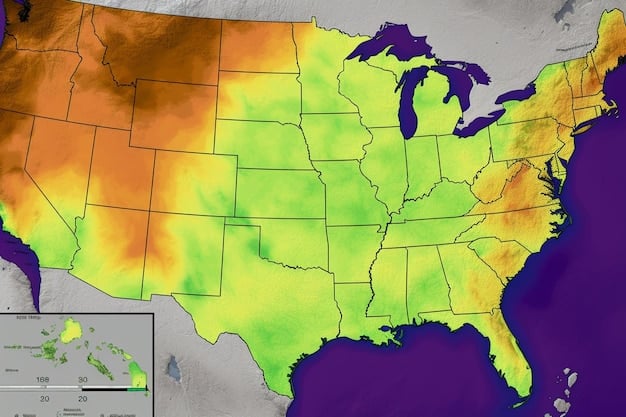How to Prepare Your Family for a Natural Disaster: A 2025 Guide

Preparing your family for a natural disaster in 2025 involves creating a comprehensive plan, assembling emergency kits, staying informed about local risks, and practicing response strategies to ensure everyone’s safety and well-being.
Knowing how to prepare your family for a natural disaster: A step-by-step guide for 2025 is crucial, as unexpected events can strike anytime. This guide provides actionable steps to help your family stay safe and resilient in the face of any natural disaster.
Understanding Natural Disaster Risks in Your Area
The first step in preparing your family for a natural disaster is to understand the specific risks in your geographic area. Different regions face different threats, and knowing what to expect is crucial for effective preparation.
Consider factors such as your proximity to the coast, earthquake fault lines, floodplains, and areas prone to wildfires. Familiarize yourself with the types of disasters most likely to occur in your community.
Identifying Local Hazards
Consult local authorities, emergency management agencies, and weather services to identify the specific natural disasters that pose a threat to your area. This information is often available on government websites and through community outreach programs.
Assessing Your Home’s Vulnerability
Examine your home’s structural integrity and identify potential weaknesses that could be exacerbated by a natural disaster. For example, if you live in an earthquake-prone area, consider retrofitting your home to make it more resistant to seismic activity.
- Coastal Regions: Prepare for hurricanes, tsunamis, and coastal flooding.
- Inland Areas: Be ready for tornadoes, severe thunderstorms, and flash floods.
- Earthquake Zones: Focus on earthquake preparedness, including securing heavy objects and reinforcing your home’s structure.
Understanding the specific risks in your area allows you to tailor your preparedness efforts effectively, ensuring that your family is ready for the most likely threats. This knowledge also informs the types of supplies you need and the specific safety measures you should take.

By understanding and addressing these risks, you can significantly increase your family’s safety and resilience in the face of natural disasters.
Creating a Family Emergency Plan
A well-thought-out family emergency plan is essential for ensuring everyone knows what to do in the event of a natural disaster. This plan should cover communication, evacuation routes, designated meeting places, and individual responsibilities.
Regularly review and practice the plan with all family members, ensuring everyone understands their roles and responsibilities. This proactive approach will help reduce panic and confusion during an actual emergency.
Communication Protocols
Establish clear communication protocols, including a designated out-of-state contact person who can serve as a central point of contact for family members who may be separated. Ensure everyone knows the contact information and how to reach them.
Evacuation Strategies
Identify multiple evacuation routes from your home and neighborhood, considering various types of natural disasters. Designate a safe meeting place outside your home and a secondary meeting place outside your neighborhood in case your primary location is inaccessible.
Assigning Responsibilities
Delegate specific responsibilities to each family member based on their age and abilities. This could include gathering emergency supplies, assisting younger siblings or elderly relatives, and ensuring pets are safely accounted for.
- Practice Regularly: Conduct regular drills to ensure everyone is familiar with the evacuation routes and meeting places.
- Update Annually: Review and update the plan annually to reflect changes in family circumstances or local conditions.
- Keep it Accessible: Ensure the plan is easily accessible to all family members, both in physical and digital formats.
Having a well-defined and practiced family emergency plan will significantly improve your family’s ability to respond effectively and safely to a natural disaster. This proactive approach ensures that everyone knows what to do and how to stay connected during a crisis.
By focusing on communication, evacuation, and assigned responsibilities, you can create a resilient and prepared family unit.
Assembling Emergency Supply Kits for Home and Car
Having well-stocked emergency supply kits at home and in your car is crucial for providing essential resources in the immediate aftermath of a natural disaster. These kits should include food, water, first-aid supplies, tools, and other necessities to help your family survive until assistance arrives.
Pay close attention to the contents of your kits, ensuring they are regularly checked and updated to account for expiration dates and changing needs. A well-maintained kit can make a significant difference in your family’s comfort and safety during an emergency.
Home Emergency Kit
Your home emergency kit should contain enough supplies to sustain your family for at least 72 hours. This includes non-perishable food, bottled water, a first-aid kit, flashlights, batteries, a battery-powered radio, and personal hygiene items.
Car Emergency Kit
Keep a smaller emergency kit in your car that includes items such as jumper cables, a flashlight, a first-aid kit, a blanket, non-perishable snacks, and water. This kit can be invaluable if you become stranded during a natural disaster.
- Water: Store at least one gallon of water per person per day.
- Food: Include non-perishable items like canned goods, energy bars, and dried fruit.
- First-Aid: A comprehensive first-aid kit should include bandages, antiseptic wipes, pain relievers, and any personal medications.
Assembling and maintaining comprehensive emergency supply kits ensures that your family has access to essential resources when they are needed most. These kits provide a vital safety net in the chaotic aftermath of a natural disaster, offering comfort and support until help arrives.
By carefully considering the contents of your home and car kits, you can enhance your family’s self-sufficiency and resilience during an emergency.
Securing Your Home Against Natural Disasters
Taking steps to secure your home against natural disasters can significantly reduce the risk of damage and injury. This includes reinforcing vulnerable areas, securing outdoor items, and taking preventative measures to protect against flooding and fire.
Implementing these measures will not only safeguard your property but also provide peace of mind knowing that you have done everything possible to protect your family and belongings.

Reinforcing Vulnerable Areas
Strengthen vulnerable areas of your home, such as windows, doors, and the roof, to withstand the impact of high winds, heavy rain, and seismic activity. Consider installing storm shutters, reinforcing garage doors, and securing your roof with hurricane straps.
Securing Outdoor Items
Secure outdoor items such as patio furniture, gardening tools, and propane tanks to prevent them from becoming projectiles during high winds or floods. Store these items in a secure shed or garage, or anchor them to the ground.
Protecting Against Flooding and Fire
Install sump pumps, elevate appliances, and clear gutters and downspouts to protect against flooding. Install smoke detectors and carbon monoxide detectors, and keep fire extinguishers readily available to prevent and respond to fires.
- Check Insurance: Review your homeowner’s insurance policy to ensure it provides adequate coverage for natural disasters.
- Maintain Landscape: Trim trees and shrubs regularly to prevent them from falling on your home during storms.
- Know Utility Shut-Offs: Learn how to safely shut off gas, water, and electricity in your home.
Securing your home against natural disasters is a proactive measure that can significantly reduce the risk of damage and injury. By reinforcing vulnerable areas, securing outdoor items, and protecting against flooding and fire, you can create a safer environment for your family and minimize potential losses.
By taking these preventative steps, you can enhance your home’s resilience and protect your family’s well-being during an emergency.
Staying Informed During a Natural Disaster
Staying informed during a natural disaster is critical for making informed decisions and taking timely action. This includes monitoring weather alerts, listening to emergency broadcasts, and utilizing reliable sources of information to stay updated on the evolving situation.
Having access to accurate and up-to-date information will help you assess the level of risk, follow evacuation orders, and take necessary precautions to protect yourself and your family.
Monitoring Weather Alerts
Subscribe to weather alerts from reputable sources such as the National Weather Service and local news outlets. Pay attention to warnings and advisories, and be prepared to take action based on the information provided.
Listening to Emergency Broadcasts
Keep a battery-powered radio on hand to listen to emergency broadcasts from local authorities. These broadcasts will provide critical updates, instructions, and warnings that can help you stay safe during a natural disaster.
Utilizing Reliable Sources of Information
Rely on trusted sources of information, such as government agencies, emergency management organizations, and reputable news outlets. Avoid spreading rumors or unverified information, which can lead to confusion and panic.
- Have a Plan for Power Outages: Keep a portable charger and extra batteries for your electronic devices.
- Communicate with Family: Use text messages or social media to communicate with family members if phone lines are down.
- Follow Official Instructions: Adhere to the instructions and guidance provided by local authorities and emergency responders.
Staying informed during a natural disaster is essential for making sound decisions and taking appropriate actions to protect your family. By monitoring weather alerts, listening to emergency broadcasts, and utilizing reliable sources of information, you can stay ahead of the situation and minimize risk.
By prioritizing access to accurate information, you can enhance your family’s safety and resilience during a crisis.
Practicing Emergency Drills with Your Family
Regularly practicing emergency drills with your family is essential for preparing everyone to respond effectively during a natural disaster. These drills should simulate different scenarios, such as evacuations, shelter-in-place situations, and communication protocols.
By conducting these drills, you can identify areas for improvement, reinforce safety procedures, and build confidence in your family’s ability to respond calmly and effectively in an emergency.
Simulating Evacuations
Conduct regular evacuation drills to practice your designated evacuation routes and meeting places. Time the drills to assess how long it takes to evacuate your home, and identify any obstacles or bottlenecks that need to be addressed.
Practicing Shelter-in-Place
Practice shelter-in-place drills to prepare for situations where it is safer to stay inside your home. Designate a safe room or area in your home, and practice sealing windows and doors to protect against external hazards.
Reinforcing Communication Protocols
Incorporate communication protocols into your emergency drills to ensure everyone knows how to reach each other and stay informed during a disaster. Practice using your designated out-of-state contact person and alternative communication methods.
- Make it a Game: Turn emergency drills into a fun and engaging activity for younger children.
- Debrief Afterwards: Discuss the drill afterwards to identify areas for improvement and reinforce positive behaviors.
- Adapt to Different Scenarios: Practice different types of drills to prepare for a variety of natural disasters.
Practicing emergency drills with your family is a vital step in ensuring everyone is prepared to respond effectively during a natural disaster. By simulating various scenarios and reinforcing safety procedures, you can build confidence and resilience in your family’s ability to handle an emergency.
By prioritizing regular drills, you can enhance your family’s preparedness and minimize the potential impact of a natural disaster.
| Key Point | Brief Description |
|---|---|
| ⚠️ Local Risks | Identify and understand the specific natural disaster risks in your area. |
| 🤝 Emergency Plan | Create a detailed family emergency plan, including communication and evacuation strategies. |
| 🎒 Supply Kits | Assemble emergency supply kits for both your home and car with essential items. |
| 🏠 Home Safety | Secure your home against potential damage from natural disasters. |
Frequently Asked Questions
▼
The most common natural disasters in the US include hurricanes, tornadoes, floods, wildfires, and earthquakes, depending on the region. It’s important to know which ones affect your area.
▼
You should store at least one gallon of water per person per day for drinking and sanitation. Aim for a 3-day supply for evacuation and a 2-week supply for home.
▼
Include non-perishable food, water, a first-aid kit, a flashlight, batteries, a battery-powered radio, personal hygiene items, and copies of important documents in your kit.
▼
You should review and update your emergency plan at least once a year to reflect changes in family circumstances or local conditions and to ensure it remains effective.
▼
Rely on trusted sources such as government agencies, emergency management organizations, and reputable news outlets for accurate information during a disaster. Avoid unverified sources.
Conclusion
Preparing your family for a natural disaster is a continuous process that requires ongoing effort and attention. By understanding the risks in your area, creating a comprehensive emergency plan, assembling emergency supply kits, securing your home, staying informed, and practicing emergency drills, you can significantly enhance your family’s safety and resilience in the face of any natural disaster. Taking these steps will provide peace of mind knowing that you have done everything possible to protect your loved ones.





